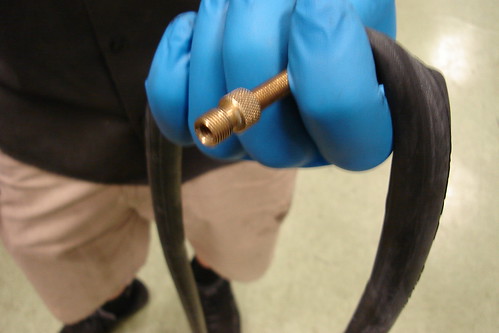if you're not handy with tools and some basic electrical and plumbing, it's probably a good idea to let someone qualified to do the work mess around with critical bus systems like brakes, the throttle etc.....however, the more you work on stuff, the better your understanding becomes of your bus as a whole. I wouldn't be nearly as afraid to try and "fix" a broken throttle as i would the braking system.
if you examine your gas pedal assembly carefully, you'll see that there are 2 hoses that attach to it. They may connect underneath through the floor. Assuming you have an air throttle......
the air line if you need to buy any for stuff in your bus is available at any big truck (semi truck) parts place. every big city has at least one of these places. i think it's just called "dot airline" it's not too pricey. anyplace that sells the airline should also sell the connectors, tee's elbow's etc that you may also need. the hardware store also has fittings and many times at a cheaper price.
The nuts that connect the air line to the throttle assembly, or any other elbow, connector etc is usually standard "npt" thread. This is the same thread used on black (and brass/galvanized...use brass!) pipe from the hardware. If it's not npt, you need to adapt to npt thread so that you can connect your air gauge. it might be compression or flair....but as far as i know, those are the only three common threads used in air systems.
there are prob more than one way to find out if it has a pressure regulator in that particular air circuit......i think the easiest way is to disconnect the air line from the gas pedal assembly, and hook the line to a pressure guage. Make sure you use the air line going "in" to the pedal assmbly, and not the on going "out" you won't hurt anything, but the expierment won't work.
You can find a guage at home depot or any other hardware that sells plumbing stuff...you'll pay less money if you can go to harbor freight or some other junk tool store. a gauge like this:

It may be a cheaper alternative to put a shrader? valve (tire valve stem)

on the end of it, then check the pressure with a tire gauge that will read up to at least 120 psi.
connect the valve, start the bus and let it build up to max air pressure, then see if the guage you just installed reads fairly close to the gauges on the dash. If the stock gauge on the dash says 120 psi, and the gas pedal gauge reads 40 psi ( or anythign vastly different from the other gauge) then there is a regulator in the circuit.
you could skip the above process:
it may just be easier to find the solenoid valve that turns on/off the air pressure going to the gas pedal. you can shut the bus off, chock the drive wheels, then crawl around under neath and listen carefully while someone inside the bus actuates the switch that seems to be killing your gas pedal. probably the ignition has to be on, the parking brake might have to be off, the doors closed etc. whatever it usually takes for the gas pedal to work. then have your buddy turn on/off the headlight switch over and over again until you locate the thing that has air lines and electric wires running to it and "clunks" or "clicks" every time the switch is turned on/off. Most solenoid switches make a fair bit of noise when the turn on/off. Once you locate this valve, you need to figure out a couple of things....get a volt meter, and find out wich of the 2 wires have 12 volts + going to it when the switch is either on/off. If the wire has 12 v+ when the switch is turned on, all you need to do it cut the wire and tape the ends. Gas pedal should work all the time. The other possibility is that it has 12 volts when the switch is turned off. in which case you'll still need to cut the wire, but also run a 12 volt + wire from your ignition to the part of the wire you just cut that connects to the soleniod.
does that make it just about as clear as mud?